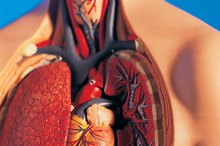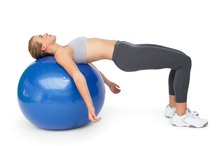Respiratory Splinting: Splinting to Help You Breathe
Breathing gets difficult when you break a rib or have surgery between your waist and shoulders. When you move broken bone ends against each other or flex muscles stitched together with wire or twine, you experience pain. Splinting is a way to immobilize or cushion those movements so you can fully expand your lungs or cough with a little less discomfort, as described by physicians at the University of Texas Medical Branch.
If you are experiencing serious medical symptoms, seek emergency treatment immediately.
Emergency
Broken bones and severed muscles are not always the result of surgery. A severe back or chest injury can break ribs and collapse a lung. In that case, before help arrives, you may instinctively hold the broken ribs immobile with posture and your arms, allowing only the healthy side of your chest to expand for breathing. This posture is a natural, voluntary splinting to immobilize injured anatomy and minimize pain.
- Broken bones and severed muscles are not always the result of surgery.
- This posture is a natural, voluntary splinting to immobilize injured anatomy and minimize pain.
Postoperative Complications
Breathing Exercises After Heart Surgery
Learn More
Surgery is controlled trauma. Severed bones and muscles are not injured by ordinary breathing, but deep breathing and coughing are necessary -- though a strong cough extends your chest's range of motion to painful lengths. Your lungs produce an endless supply of mucus to trap and carry away inhaled dust and smoke. The gentle massage of breathing is part of the way your lungs expel mucus. But breathing is usually very shallow post-operatively, as described by practitioners writing for "Nursing Care Plan." Mucus accumulates and may lead to pneumonia. Pillow splinting and manual splinting allow full lung expansion and a strong cough with minimal pain.
- Surgery is controlled trauma.
- The gentle massage of breathing is part of the way your lungs expel mucus.
Pillow Splinting
Pillow splinting is done either seated upright or lying down, holding a pillow over the incision site -- whether abdominal, chest or on either side. The best technique is to wrap both arms or hands as fully as possible across the pillow and press firmly. A slow, deep breath in produces less discomfort in this position. You can cough at the top of this deep breath, pressing firmly as you do so. Splinting is also used at least four times an hour to make it easier to take a series of slow, relaxed deep breaths in and out to keep your lungs expanded, mucus-free and healthy.
- Pillow splinting is done either seated upright or lying down, holding a pillow over the incision site -- whether abdominal, chest or on either side.
- The best technique is to wrap both arms or hands as fully as possible across the pillow and press firmly.
Manual Splinting
Breathing Exercises to Improve an Upper Respiratory Infection
Learn More
Manual splinting doesn't use a pillow. This may be easier for a lateral incision -- for instance, midway down the side of your right chest wall. In this case, you would place your left palm a few inches above the incision and your right palm a few inches below. While pressing firmly, though not hard enough to produce pain, manually splinted breathing follows the same procedure for coughing and deep breathing as with pillow splinting.
- Manual splinting doesn't use a pillow.
- This may be easier for a lateral incision -- for instance, midway down the side of your right chest wall.
Complications
After discharge from the hospital, you probably won't have a respiratory therapist or nurse available to remind and coach you in splinting for coughing and deep breathing 3. Until you return to normal mobility and activities of daily living, lung expansion and clearance are important. Retained mucus and unexpanded lungs breed bacteria, lower oxygen levels and commonly lead to pneumonia, re-hospitalization, more lost workdays and greater expense.
Related Articles
References
- Nursing Care Plan: Nursing Diagnosis: Ineffective Airway Clearance
- YouTube: Respiratory Care: Cough Splinting
- Apostolis C, Wallace K, Sasson P, Hacker MR, Elkadry E, Rosenblatt PL. Assessment of women with defecatory dysfunction and manual splinting using dynamic pelvic floor magnetic resonance imaging. Female Pelvic Med Reconstr Surg. 2012;18(1):18-24. DOI:10.1097/SPV.0b013e31823bdb98
- Steele SR, Mellgren A. Constipation and obstructed defecation. Clin Colon Rectal Surg. 2007;20(2):110–117. doi: 10.1055/s-2007-977489
- Beck DE, Allen NL. Rectocele. Clin Colon Rectal Surg. 2010;23(2):90–98. doi:10.1055/s-0030-1254295 doi: 10.1055/s-0030-1254295
- Apostolis, C., et. al. "Assessment of Women With Defecatory Dysfunction and Manual Splinting Using Dynamic Pelvic Floor Magnetic Resonance Imaging" Female Pelvic Medicine & Reconstructive Surgery 2012 18:18-24.
Writer Bio
Walt Pickut has published peer-reviewed medical research since 1971. Pickut teaches presentational speaking and holds board registries in respiratory care and sleep technology. He is a member of the Society of Professional Journalists and the American Society of Business Publication Editors and is editor for "The Jamestown Gazette." Pickut holds bachelor's degrees in biology and communication, and master's degrees in physiology and mass communication.







